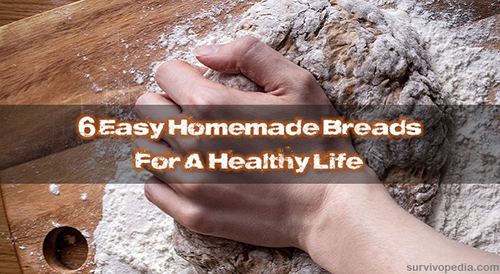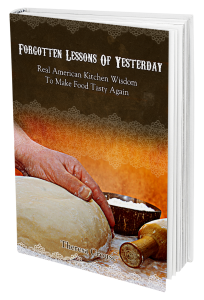Bread is a staple in most diets and can be a real lifesaver, literally, when it comes to surviving. Unfortunately modern store-bought bread has very little nutrition.

However, you can make many different kinds of bread at home that are nutritious and good for you even if you have such conditions as diabetes, gluten intolerance, allergies or other issues that may otherwise be affected by bread consumption.
If you have diabetes, you obviously need to watch your carbohydrate consumption in order to keep your blood sugar under control. Fortunately, there are many bread recipes that use nut flours or whole grains that contain the fiber you need to counteract the carbohydrates. These recipes will help you enjoy bread without spiking your blood sugar.
If you have a gluten intolerance or celiac disease, you can’t have wheat, rye, barley or triticale because of the protein, gluten, found in the bread.
Up til recently, the only gluten-free bread options were either gross or prohibitively expensive. Most of these recipes are gluten-free and guaranteed to taste better than store-bought bread.
Nut allergies are also a concern for many people. Unlike some other allergies, a nut allergy is often extremely dangerous; people die from exposure. We included nut-free recipes in here, too!
6 Easy Homemade Breads
1. Basic White Bread
This recipe is good for diabetics and is nut-free.
- 4 t bread machine yeast
- 1/2 t sugar
- 1 1/4 cups water (90-100 F)
- 3 T olive oil
- 3/4 t baking powder
- 1 t salt
- 1 T sugar substitute
- 1 cup vital wheat gluten flour
- 1/4 cup oat flour
- 3/4 cup almond flour
- 1/4 cup flax seed
- 1/4 cup wheat bran
Directions:
- Put the water, oil and sugar in your bread maker.
- In a separate bowl, mix all the dry ingredients with the exception of the yeast and baking powder.
- Mix well.
- Take out approximately 1/4 cup.
- Pour the rest of dry ingredients into the pan.
- Mix the reserved 1/4 cup of dry ingredients with the yeast and baking powder.
- Pour into the bread machine pan.
- Use the three hour bake cycle.
- After 55 minutes, gently lift the dough out and remove the paddle and place the dough back into the machine so that you don’t have a huge hole in your finished loaf.
2. Low Glycemic Index Banana Bread
This recipe is courtesy of the Weight Watcher website and is good for diabetics and people with nut allergies.
- 3 very ripe bananas
- 1 cup sugar substitute
- 1/2 cup natural applesauce
- 3/4 cup all-purpose flour
- 1/2 cup whole wheat flour
- 1/2 t salt
- 1 1/2 t baking soda
Directions:
- Preheat oven to 350 degrees.
- In a mixer, mash bananas, add sugar substitute and mix.
- Mix in rest of ingredients.
- Pour ingredients into a greased bread pan.
- Bake for 50 to 60 minutes or until a toothpick comes out clean.
- Remove from pan and cool on a wire rack.
*If using a dark coated pan, bake at 325 degrees and bake a little longer.
Video first seen on Heartland Country Stor
3. Light Fluffy Cheddar Bacon Biscuits
These biscuits are easy to make and are diabetic-friendly, gluten-free and nut-free. Oh yeah, and delicious!
- 1/4 cup butter, melted and slightly cooled.
- 1/3 cup sifted coconut flour
- 4 eggs
- 1/4 teaspoon salt
- 1/4 teaspoon garlic powder
- 1/4 teaspoon baking powder
- 1 cup sharp cheddar cheese, shredded
- 1/2 cup diced bacon, optional
Directions:
- Preheat oven to 400 degrees.
- Grease a cookie sheet.
- Mix eggs, butter, salt, and garlic powder.
- Add flour and baking powder and mix until there are no lumps.
- Fold in cheese and bacon.
- Drop batter by the heaping tablespoon onto greased cookie sheet.
- Bake for 15 minutes, or until lightly browned.
- Let cool for 5-10 minutes before removing and serving. Cool completely before storing.
4. Cinnamon Flax Muffin
This recipe is a bit unique and well-suited to survival because it’s only for a single muffin. You can make it in the microwave or in the oven, or even in a cup over a fire if you use a lid.
It’s diabetic-friendly, gluten-free and nut-free.
- 1 large egg
- 1 T honey
- 1 1/2 t cinnamon
- 2 t plain fat-free yogurt
- 1/2 t baking powder
- 3 T ground flax seeds
Directions:
- Spray a microwave safe coffee cup or bowl with cooking spray.
- Mix the egg and honey until well combined, add the yogurt and blend well.
- Mix in the ground flaxseed, cinnamon and baking powder until well combined.
- Pour in coffee cup so that it’s no more than half full and microwave on high for 1 1/2 minutes.
- Serve hot.
5. Rosemary Herb French Bread
This recipe is good for diabetics and is gluten-free, nut-free, soy-free and dairy-free.
- 3/4 cup sorghum flour
- 1/4 cup millet flour
- 1/2 cup tapioca flour
- 1/2 T xanthan gum
- 3/4 t salt
- 1 t egg replacer, dry. Skip this if you’re using real eggs.
- 1 T sugar
- 3/4 cup lukewarm water
- 1 T rapid-rise yeast
- 1 T olive oil
- 2 t egg replacer whisked with 6 tbsp. warm water or 3 eggs, if eggs aren’t an issue
- 1/2 t vinegar
- 1 T olive oil
- 1/2 T crushed rosemary
- 1/2 T kosher salt
Directions:
- Preheat oven to 375F.
- Grease sides of French bread pan or regular loaf pan and sprinkle with cornmeal.
- Combine dry ingredients in a medium mixing bowl of a standing mixer and combine.
- Put sugar and lukewarm water in a small bowl and add yeast and allow it to activate.
- Add the yeast water to the medium mixing bowl.
- Add first amount of olive oil, egg replacer “Eggs” or regular eggs and vinegar and mix on medium for 3 minutes.
- Carefully scoop out your dough and make a bread-shaped loaf. Baste with remaining oil or melted butter and make a few decorative slices in the top if you want. Sprinkle with rosemary and salt.
- Let rise for 20-30 minutes or until about doubled in size.
- Bake for 25-30 minutes or until bread is browned and sounds slightly hollow when you tap it.
- Allow to cool for several minutes then remove from pan.
Video first seen on Heartland Country Stor
6. Wonderful Wheat-Free Wheat Bread
This bread has a pleasant, nutty flavor and works well as a sandwich bread. It’s also great with just butter. It’s diabetic friendly, gluten-free, dairy-free and nut-free.
- 2 cups almond flour
- 2 T coconut flour
- 1/4 cup flax meal
- 1/4 t sea salt
- 1/2 t baking soda
- 5 eggs
- 1 T coconut oil
- 1 T honey
- 1 T apple cider vinegar
Directions:
- Place almond flour, coconut flour, flax, salt and baking soda in a food processor and pulse to combine.
- Pulse in eggs, oil, honey and vinegar until well-combined.
- Transfer batter to a greased 7 1/2″ x 3 1/2” loaf pan. Don’t worry if the texture is looser than “regular” dough. That’s the way that it’s supposed to be.
- Bake at 350° for 30 minutes.
- Allow to cool in the pan for 2 hours.
- Serve and enjoy!
We hope that these breads make you happy as well as healthy!
If you try them, please tell us about your experience in the comments section below. Likewise, if you have a recipe that you’d like to share, please do so!
Theresa Crouse wrote the book ”Forgotten Lessons of Yesterday” that covers all her recipes and many lost skills our grandparents had back in the day. You can have her book by clicking the book image below.
This article has been written by Theresa Crouse for Survivopedia.
Want to be as self-sufficient as possible? Want to know how our grandfathers made traditional bark bread? Then you really need this amazing step-by-step guide. It is called The Lost Ways and it contains all the knowledge of our forefathers.
Here’s just a glimpse of what you’ll find in The Lost Ways:
From Ruff Simons, an old west history expert and former deputy, you’ll learn the techniques and methods used by the wise sheriffs from the frontiers to defend an entire village despite being outnumbered and outgunned by gangs of robbers and bandits, and how you can use their wisdom to defend your home against looters when you’ll be surrounded.
Native American ERIK BAINBRIDGE – who took part in the reconstruction of the native village of Kule Loklo in California, will show you how Native Americans build the subterranean roundhouse, an underground house that today will serve you as a storm shelter, a perfectly camouflaged hideout, or a bunker. It can easily shelter three to four families, so how will you feel if, when all hell breaks loose, you’ll be able to call all your loved ones and offer them guidance and shelter? Besides that, the subterranean roundhouse makes an awesome root cellar where you can keep all your food and water reserves year-round.
From Shannon Azares you’ll learn how sailors from the XVII century preserved water in their ships for months on end, even years and how you can use this method to preserve clean water for your family cost-free.
Mike Searson – who is a Firearm and Old West history expert – will show you what to do when there is no more ammo to be had, how people who wandered the West managed to hunt eight deer with six bullets, and why their supply of ammo never ran out. Remember the panic buying in the first half of 2013? That was nothing compared to what’s going to precede the collapse.
From Susan Morrow, an ex-science teacher and chemist, you’ll master “The Art of Poultice.” She says, “If you really explore the ingredients from which our forefathers made poultices, you’ll be totally surprised by the similarities with modern medicines.” Well…how would you feel in a crisis to be the only one from the group knowledgeable about this lost skill? When there are no more antibiotics, people will turn to you to save their ill children’s lives.
And believe it or not, this is not all…
Table Of Contents:
Making Your Own Beverages: Beer to Stronger Stuff
Ginger Beer: Making Soda the Old Fashioned Way
How North American Indians and Early Pioneers Made Pemmican
Spycraft: Military Correspondence During The 1700’s to 1900’s
Wild West Guns for SHTF and a Guide to Rolling Your Own Ammo
How Our Forefathers Built Their Sawmills, Grain Mills,and Stamping Mills
How Our Ancestors Made Herbal Poultice to Heal Their Wounds
What Our Ancestors Were Foraging For? or How to Wildcraft Your Table
How Our Ancestors Navigated Without Using a GPS System
How Our Forefathers Made Knives
How Our Forefathers Made Snow shoes for Survival
How North California Native Americans Built Their Semi-subterranean Roundhouses
Our Ancestors’Guide to Root Cellars
Good Old Fashioned Cooking on an Open Flame
Learning from Our Ancestors How to Preserve Water
Learning from Our Ancestors How to Take Care of Our Hygiene When There Isn’t Anything to Buy
How and Why I Prefer to Make Soap with Modern Ingredients
Temporarily Installing a Wood-Burning Stove during Emergencies
Making Traditional and Survival Bark Bread…….
Trapping in Winter for Beaver and Muskrat Just like Our Forefathers Did
How to Make a Smokehouse and Smoke Fish
Survival Lessons From The Donner Party
Get your paperback copy HERE
CHECK OUR survival and prepping solutions
If you found this article useful, please like our Facebook page and stay up to date with the latest articles.
WHAT TO READ NEXT:
HOW TO MAKE YOUR OWN BACON (STEP BY STEP GUIDE)
A RETURN TO THE OLD PATHS: HOW TO MAKE PEMMICAN LIKE THE NATIVE AMERICANS
20 LOST RECIPES FROM THE PIONEERS: WHAT THEY COOKED ON THEIR JOURNEY WESTWARD
SEVEN CLASSIC GREAT DEPRESSION ERA RECIPES GRANDMA USED TO MAKE
POTTED MEAT: A LOST SKILL OF LONG TERM MEAT STORAGE
BACK TO BASICS: HOW TO MAKE AND PRESERVE LARD
THE BEST WAY TO STOCKPILE VEGETABLES OFF-GRID
OLD FASHIONED PRESERVING-GRANDPA’S RECIPE FOR CURED SMOKED HAM
HOW TO MAKE GUNPOWDER THE OLD FASHIONED WAY
SURVIVAL HERBAL RECIPES FROM OUR ANCESTORS
HOW TO PRESERVE MEAT FOR SURVIVAL LIKE OUR GRANDFATHERS
OTHER USEFUL RESOURCES:
The 3 Pioneer Survival Lessons We Should Learn
The Most Effective Home Defense Strategies
Old School Hacks for Off-Grid Living
The Medical Emergency Crash Course

